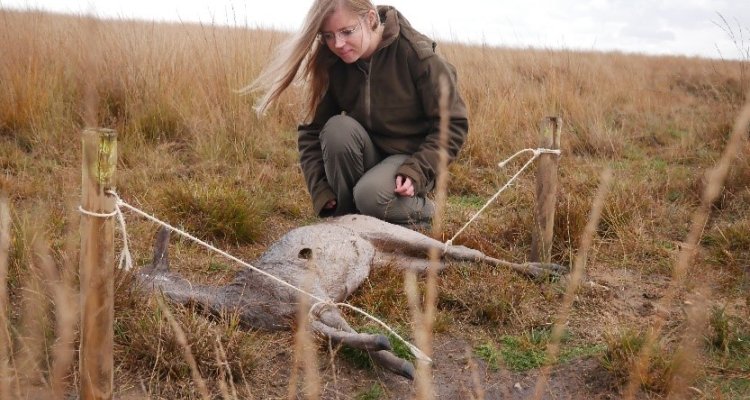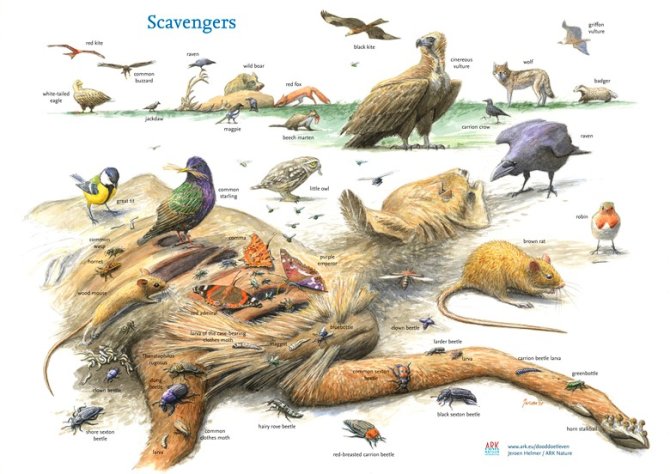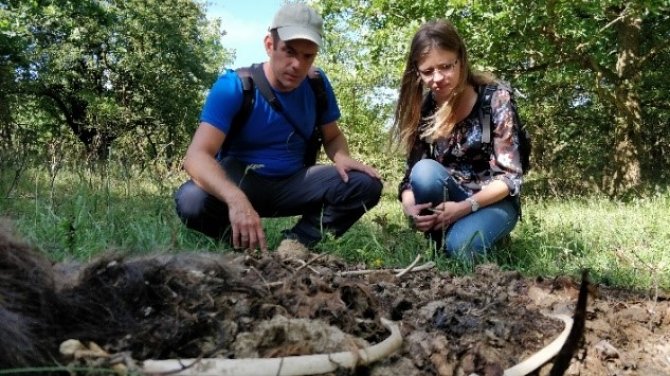
Project
The importance of carcasses in nature
How do dead animals (i.e. “carcasses”) decompose in nature? Which nutrients are stored in the bodies of carcasses? How important is the role of scavengers in the recycling process of these nutrients, and how important is it in the entire ecosystem? These are key questions in the PhD research of Elke Wenting.
Imagine an animal dies in nature. What will happen? Will other animals (i.e. “scavengers”) eat it, or will it decompose on the spot? Although scavengers are often associated with the African savanna, they are at least even important in western European ecosystems. Examples of scavengers are birds like raven and buzzard, mammals like fox and wild boar, and plenty of insects (e.g. beetles and flies). The question is: why are carcasses a beloved food source for such a wide variety of species?
Reservoir of nutrients
All living organisms consist of nutrients, that are needed to build up a body and to maintain its life functions. Animals gather their required nutrients over large areas and long timespans, and accumulate these nutrients in their bodies. Some nutrients are scarce and hard to gather for basically all animals, like cobalt and selenium. Especially in nutrient-poor ecosystems, e.g. the Veluwe, this can be a daunting task.
When an animal dies, the nutrients stored in its body suddenly become available for scavengers. But scavengers are not the only organisms that want to feed on the carcass - at the moment an animal dies, a real race starts between scavengers and microbes (e.g. bacteria).
Like scavengers, microbes also want to feed on the carcass, but they eat much slower than the scavengers. Therefore, microbes need other “tools” to compete with the scavengers. The idea is that they try to render the carcass as disgusting, and so unusable, to the scavengers as fast as possible. when the scavengers fast enough in detecting and consuming a carcass, they can eat the carcass before the microbes have rendered it. In that scenario, the scavengers “win”. But, when the scavengers are too late, the carcass is already spoiled and unusable at the moment they detect it. Then, the microbes “win”.
We think that the nutrients stored in carcasses recycle faster when there are lots of scavengers in an ecosystem. Scavengers can disperse the nutrients over much larger areas than microbes can do. As a result, the nutrients are recycled faster into the soil, and so become faster available to plants. We predict that, ultimately, there can live more plants and animals - more biodiversity - in areas with ordinary carcass supply and lots of scavengers present. This positive effect would be even greater in nutrient-poor ecosystems, e.g. the Veluwe.
Scavenger presence or absence
During this PhD research, Elke Wenting tests how the scavengers that are present in an ecosystem determine how carcasses decompose. She tests this in several experiments. For example, in Veluwezoom National Park - a nature reserve characterized by its diverse scavenger community -, she systematically excludes subsets of scavengers from carcasses: e.g. excluding, wild boar, all mammals, all birds, etc. Elke monitors what happens with the nutrients by periodically measuring the soil nutrients beneath the carcasses.
The outcomes of this PhD research will provide new insights into the impact of population management on scavenger populations and how this affects the natural cycle of nutrients in ecosystems. Furthermore, it will provide new insights into how - and why - the presence of carcasses can contribute to biodiversity and ecosystem functioning, especially in nutrient-poor ecosystems.
Publications
Wenting, E., Jansen, P.A., Burggraeve, S., Delsman, D.F., Siepel, H., & van Langevelde, F. (2024). The influence of vertebrate scavengers on leakage of nutrients from carcasses. Oecologia, 1-15. https://doi.org/10.1007/s00442-024-05608-w.
Wenting, E., Jansen, P.A., Laugeman, M.J.B., & Van Langevelde, F. (2023) Leakage of nutrients into the soil due to carrion decomposition can enhance plant growth. Journal of Soil Science and Plant Nutrition (2023). https://doi.org/10.1007/s42729-023-01430-0
Wenting, E., Siepel, H., Christerus, M., & Jansen, P. A. (2023). Ionomic variation among tissues in fallow deer (Dama dama) by sex and age. Biological Trace Element Research, 1-15. https://doi.org/10.1007/s12011-023-03724-x
Wenting, E., Siepel, H., & Jansen, P. A. (2020). Stoichiometric variation within and between a terrestrial herbivorous and a semi-aquatic carnivorous mammal. Journal of Trace Elements in Medicine and Biology, 62, 126622. https://doi.org/10.1016/j.jtemb.2020.126622
Wenting, E., Rinzema, S.C.Y., Van Langevelde, F., 2022. Functional differences in scavenger communities and the speed of carcass decomposition. Ecology and Evolution 12, e8576. https://doi.org/10.1002/ece3/8576
Wenting, E., Siepel, H., & Jansen, P. A. (2023) Variability of the Ionome of Wild Boar (Sus scrofa) en Red Deer (Cervus Elaphus) in a Dutch National Park, with Impications for Biomonitoring. Biological trace element research, 1-29. https://doi.org/10.1007/s12011-023-03879-7
Wenting, E., Jansen, P.A., Pattipeilohy, L., van Lunteren, P., Siepel, H., & van Langevelde, F. (2024) Influence of tree cover on carcass detection and consumption by facultative vertebrate scavengers. Ecology and Evolution, 14, e10935. https://doi.org/10.1002/ece3.10935
Funded by
This project is funded by: Graduate School for Production Ecology & Resource Conservation
Media (only in Dutch)
Nieuwe Veluwe | Editie 1/23, Dode dieren in de kringloop van de natuur
Omroep Gelderland | 21 april 2024
Resource Magazine | 16 november 2022 | Dood doet Leven
Omroep Gelderland | 8 october 2022 | Dood doet Leven
Trouw | 5 december 2021 | De staat van ontbinding: nut en noodzaak van kadavers in het wild
KIJK Magazine | 09/2021 | Kadavers voor de wetenschap
Vroege Vogels TV | 27 november 2020 | Veluwezoom
Omroep Gelderland | 13 september 2020 | Slimme zwijnen verstoren onderzoek naar kadavers
Nature Today | 5 juli 2020 | Unieke eerste beelden van wolf en aaseters bij wolvenprooi
Vroege Vogels Radio | 5 juli 2020 | Unieke beelden van wolf en aaseters bij wolvenprooi
Quest Magazine | 08/2020 | Smullen van kadavers
Staatsbosbeheer Magazine | summer 2020 | Er is leven na de dood
Nature Today | 8 april 2020 | Dood doet Leven voor raaf, vos, wild zwijn én wolf
Nature Today | 29 september 2019 | Dood doet Veluwse natuur leven
Omroep Gelderland | 3 maart 2019 | Wat is er nog over van de KadaverCam-ree?

